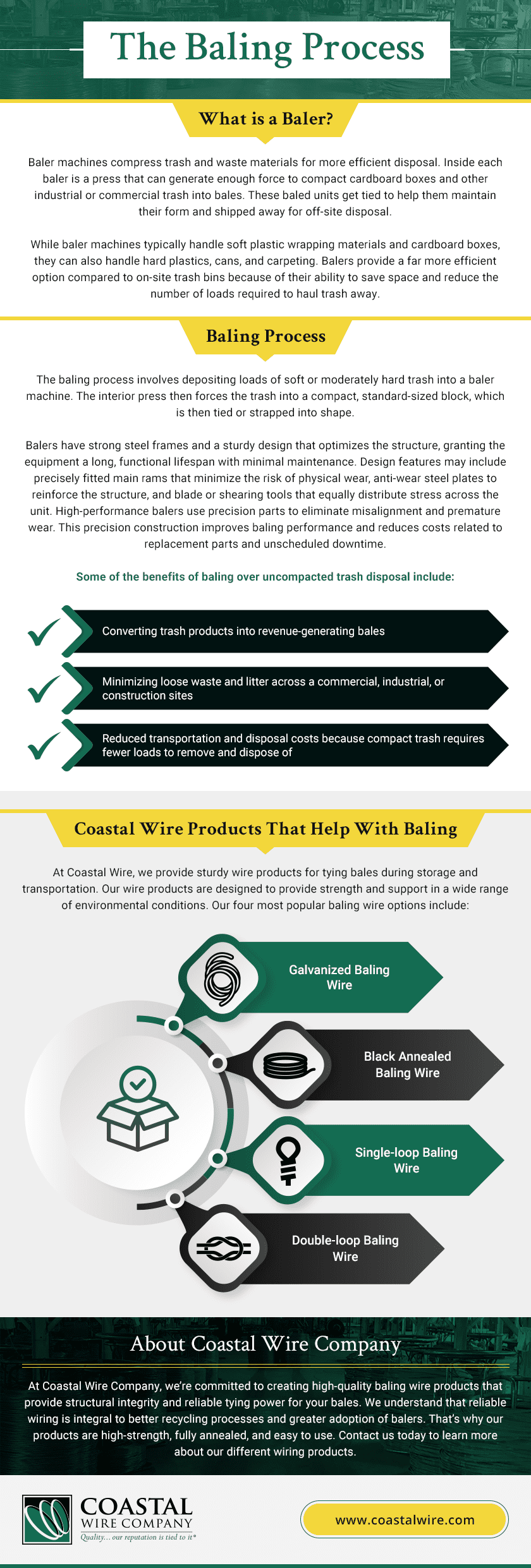The Process of Baling
What is a Baler?
Baler machines compress trash and waste materials for more efficient disposal. Inside each baler is a press that can generate enough force to compact cardboard boxes and other industrial or commercial trash into bales. These baled units get tied to help them maintain their form and shipped away for off-site disposal.
While baler machines typically handle soft plastic wrapping materials and cardboard boxes, they can also handle hard plastics, cans, and carpeting. Balers provide a far more efficient option compared to on-site trash bins because of their ability to save space and reduce the number of loads required to haul trash away.
Baling Process
The baling process involves depositing loads of soft or moderately hard trash into a baler machine. The interior press then forces the trash into a compact, standard-sized block, which is then tied or strapped into shape.
Balers have strong steel frames and a sturdy design that optimizes the structure, granting the equipment a long, functional lifespan with minimal maintenance. Design features may include precisely fitted main rams that minimize the risk of physical wear, anti-wear steel plates to reinforce the structure, and blade or shearing tools that equally distribute stress across the unit. High-performance balers use precision parts to eliminate misalignment and premature wear. This precision construction improves baling performance and reduces costs related to replacement parts and unscheduled downtime.
Some of the benefits of baling over uncompacted trash disposal include:
- Converting trash products into revenue-generating bales
- Minimizing loose waste and litter across a commercial, industrial, or construction sites
- Reduced transportation and disposal costs because compact trash requires fewer loads to remove and dispose of
Coastal Wire Products That Help With Baling
At Coastal Wire, we provide sturdy wire products for tying bales during storage and transportation. Our wire products are designed to provide strength and support in a wide range of environmental conditions. Our four most popular baling wire options include:
- Galvanized baling wire. This wiring has a zinc coating to prevent rust and corrosion from damaging the integrity of the wire. It’s rated as extra-strong, making it ideal for scrap metal, tire, and wood bales.
- Black annealed baling wire. Annealing is a finishing process that imbues metal materials with additional positive characteristics, such as resistance to corrosion. The annealing process imparts a protective black surface layer to the metal. Along with baling, this wiring sees frequent use in consumer processes, such as handcrafting.
- Single-loop baling wire. Our single-loop baling wire is sturdy and reliable enough for use with vertical balers, minimizing the risk of failure during feeding and tying. In vertical balers, wiring gets fed through the slots and wraps around the bales for operators to tie by hand. If the metal isn’t suitably strong, it will snap. Strong wiring saves operators from re-baling spilled trash.
- Double-loop baling wire. This wire is manipulated into perfectly formed loops that link together. It’s essential to choose double-loop baling wire from a reliable, high-quality provider. The loops must be identically sized to create a sturdy, reliable connection. Using lower-quality double-loop baling wire risks varying tensile strength among the loops around a given bale, which may cause the bale to distort or come apart completely.
About Coastal Wire Company
At Coastal Wire Company, we’re committed to creating high-quality baling wire products that provide structural integrity and reliable tying power for your bales. We understand that reliable wiring is integral to better recycling processes and greater adoption of balers. That’s why our products are high-strength, fully annealed, and easy to use. Contact us today to learn more about our different wiring products.


